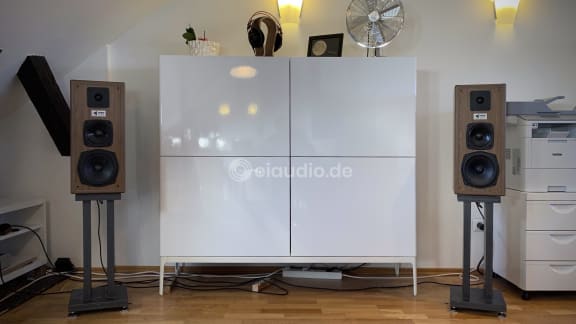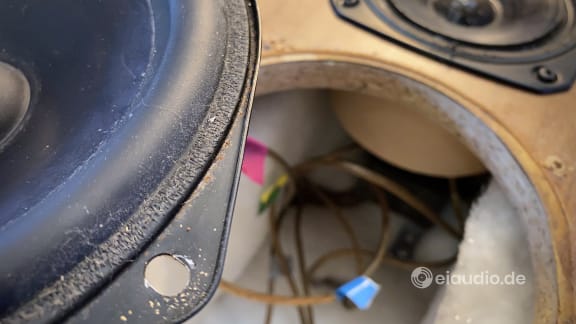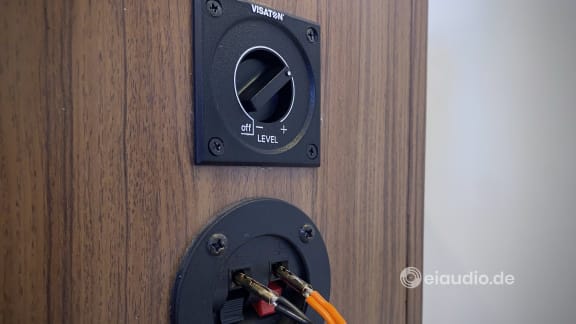Orbid Sound Pluto (kit)
Published: 30/05/2022
Manufacturing date: 1992
Author: Karsten Hein
Category: Gear & Review
Tag(s): Loudspeakers
Our family had just returned from living in the United States and was coming to terms with the adjustments of living in Germany, when a friend of mine introduced me to Mr Beyersdorffer’s infamous Orbid Sound loudspeaker company. Seeing that I had an interest in audio gear, he handed me a brochure that seemed to give away lots of secrets regarding the production and sale of loudspeakers. In this, Mr Beyersdorffer claimed that the established audio companies were ripping off their customers by packaging cheap drivers into fancy-looking boxes, hoping that enough paying customers would be attracted by their paid-for (and therefore always positive) reviews in the audio press.
Mr Beyersdorffer explained that Orbid Sound could work with superior drivers at a far lower price point than the audio establishment, since his company did not advertise in expensive magazines, and instead had built its reputation on word-of-mouth from its happy customers alone. His claims were not without truth, of course, with Hi-Fi stores selling speakers based on their high wattage figures, increasingly dubious frequency curves, and accentuated treble response—the latter being directed at affluent pensioners who were happily smiling that they could once again hear the upper ranges of the frequency spectrum. These were the days in which low-budget speaker manufacturers would paint large shiny rings around their smallish drivers in the attempt to make their speakers look more impressive through the cloth.
However, these brands—mostly from mail-order outlets and department stores—were not the primary target of Mr Beyersdorffer’s campaign. His rantings were directed at established Hi-Fi stores, and in his audience were emerging audiophiles on a tight budget. If he could convince the youth of the day that they could play with the big boys by being cleverer than the audio establishment, he would be able to earn enough money with his company to make a living for himself, and perhaps even some more. As it turned out, my friend, my younger brother, and myself ended up buying our first ‘real’ loudspeakers from Orbid Sound.
To save money, my brother and I chose assembly kits from the company. My brother’s Pluto kit came with prefabricated cabinet parts and was easy to assemble. I decided to go one step further by building the speaker cabinet from scratch. With more than 30 years having passed since then, I have forgotten what my loudspeakers were called, I just remember that they had four small woofers each, instead of one larger one. And these woofers were paired with the Pluto’s midrange driver and tweeter. Although I liked the idea of benefiting from the reduced time-lag of four smaller bass drivers and could even follow Mr Beyersdorffer’s ideas on this, I found that the concept did not work so well in practice—perhaps due to differences in timing between the drivers—and so I sold my speakers again, just a few weeks after finishing them.
My brother, on the other hand, kept his Orbid Sound Pluto kit speakers and finally left them behind at my parents’ house when he moved out in 2006. This is precisely where I found them just the other day. I called my brother to ask if I could take them home for a listening test on our system, to which he agreed. There was a moment of pause in which we both had to snicker at the improbability of running Orbid Sound speakers on a 'grown-up' stereo system. How would they compare against the high musical standards set by our vintage classics, let alone the modern Tannoy XT8f dual-concentric towers, the Epicure EPI 500, or even the Martin Logan SL-3 electrostatic speakers? We decided that we could not know until we tried, and I took the Plutos home with me later that evening.
Upon further inspection, I could see that the cabinets and drivers were still in surprisingly good shape, even if the glue of the veneer edging had become a little brittle in some corners, revealing plies of multi-ply underneath. This came as a surprise to me, as I had misremembered them to be made of cheaper pressboard. Multi-ply had the added advantage that it was not as sonically dead as the MDF board that is typically used these days. So, I whipped out a bottle of Ponal wood glue to solve the issue. The drivers themselves were still sonically sound, and I could not detected any scraping when moving them by hand.
Some people had reported that Orbid Sound designed their crossovers without using coils, simply by combining resistors. However, with the crossovers being cast in hardened resin, it was difficult for me to find out how much truth there was to this claim without breaking them. In my early youth, I had also built speakers without coils in their crossovers and learnt that such designs could actually be beneficial to phase correctness in some setups. Without the low pass function of a coil choke, the woofers were simply allowed to play lower midrange frequencies. And while this may have been an option on a two-way system, I was a little suspicious in respect to a 3-way design. Some sceptic listener had even x-rayed the crossovers and suggested in an online forum that they were in fact quite conventional. Be that as it may, in the end, I decided that it was worth finding out what Orbid Sound had cooked up thirty years ago.
Following some time listening to our Epicure EPI 500 speakers, I connected the Plutos to our Dynavox VR-70 tube amplifier, which had already been well run-in at this time. The music source was our Marantz CD-17 paired with a Cambridge DAC. I positioned the Plutos in the exact position where our EPI 500 had been, with the chassis at about 105cm distance from the room's front wall, only to find that this practically eliminated all bass frequencies from the rear-ported speakers. As intended book shelve speakers, the Orbid Sounds had been designed with the room's front wall to act as bass support. This itself was not necessarily a shortcoming in real-world applications; hence, I slowly began moving the stands closer to the room's front wall. As the chassis were approaching 62cm distance, bass notes finally began to sound right.
And yet, there was a second quirk that I had noticed right from the first minute of the speakers performing. Something was off balance in the Plutos' midrange. Female voices sounded squeakier and more compressed than I was previously used to, from our other speakers (and from real-life). At first, I had thought that this effect would lessen once the bass had locked in with the room, but sadly this was not the case, and I began to wonder what the level attenuation panel at the Pluto cabinet's rear wall was actually used for: the tweeter or the midrange? When first setting the speakers up many years ago, my brother and I had chosen to install a simple wire bridge, instead of using one of the included attenuation resistors. (I think there had initially been two, but who knew where they were now?) Listening to the Plutos today, this proved to have been a mistake. I admit that back in the 90s, we used equalisers to augment speaker performance, a practice that would be seen as an unspeakable blunder in the world of audiophile listening today.
Another phenomenon that I had noticed upon first listening to the Plutos was their eagerness to cast frequencies deeply into the room. This could have even been considered a positive effect if it had also served to create a stage impression with identifiable width and depth. For some reason, however, the Orbid Sounds did this at random and with no apparent coherence. This made only three basic stage positions discernible: left, centre, right. Snare drum, high hats, guitars, and piano notes found themselves loosely afloat in the listening room, strangely devoid of all form and position. Of the Plutos' three difficulties, this last one would probably be the most difficult to fix, as it seemed to stem from timing issues between the three chassis.
If tonality could be fixed through midrange attenuation, this might be a step in the right direction. To find out, I would first need to confirm that the attenuation clamps had actually been attached to the midrange. If they had instead been connected to the tweeters, it would probably be best to give up on these speakers. But if the midrange could be reduced in volume, this might actually reduce the midband squeakiness and create some listenable speakers. The rear terminal looked large enough to house a standard Visaton attenuator. The next morning, I unmounted the woofer to have a look inside. My findings were twofold: The midrange driver really was connected to the attenuator clamps, and, even better, it was housed in a separate internal cabinet. Feeling reassured by the results of my exploration, I ordered two Visaton attenuators, thus hoping to rein in the sqeaky midrange.
The Visaton LC57 attenuators arrived just three days later and easily slotted into the existing cabinet holes of the resistor clamps. I connected pins two and three of the L-pad, thus reaching maximum resistance (minimum midrange volume) with the attenuators turned left, as was described on the face plate. And yet, a first listen to the Orbid Sounds with the new L-pads in place reminded me of an issue from first placing the fixed resistors thirty years ago: There was hardly any difference in sound...! — But how was this even possible? Normally, one would think that taking the midrange drivers out of the sonic equation should also affect the speakers' ability to perform in this area. Were the Plutos' woofers perhaps allowed to extend into midrange frequencies after all? And what may have been the point of having dedicated midrange drivers, if their presence would be hardly detectable?
Over the course of the next few days, I experimented with various distances to the listening room's front wall and also tried different settings on the attenuator dial. Even in their most becoming position—out75/in70cm front wall distance, 2/3 midrange-volume, placed at 2m distance to form an equilateral triangle with the listening position—the Pluto (kit) speakers still sounded compressed in the midrange. And although the applied attenuation did produce a mildly positive effect in terms of tonal balance, this proved less significant than expected. Granted, the Plutos were capable of producing excessive amounts of sonic information. However, they presented this in an overly eager and in-your-face fashion that would take some getting used to. Considering their entry-level priced competition of the 1990s, the Plutos' capability to present a great wealth of musical detail may even have been a welcome feature. Their ability to radiate notes deeply into the room surely was perplexing, until it also became apparent that this mostly came at the expense of losing precise musical dimension. From their very beginning, Mr Beyersdorffer's Orbid Sound had banked on the notion of setting themselves apart from the Hi-Fi mainstream, and these speakers certainly lived up to the expectation.
Note: Martin Beyersdorffer died on 1 November 2020, just a few days before reaching his 87th birthday, and the company is currently maintained in its second generation by his son Daniel Beyersdorffer and Thomas Feil.
Specifications
- Type: 3-way dynamic ported speaker
- Features: midrange adjustment via resistor
- Frequency range: 33 Hz - 20,000 Hz
- Impedance: 4 Ohms
- Power handling: 60 watts (RMS)
- Tweeter driver: 3.0 cm, soft-dome
- Tweeter model: Peerless of Denmark, SKO10 DT
- Midrange driver: 10 cm, coated paper
- Midrange model: WDH of Germany, BMT 130/19-120
- Woofer driver: 15 cm, poly-compound
- Woofer model: Peerless, 830228 (dual voice coil)
- Cabinet: Laminated multiply wood
- Cabinet volume: 27 litres
- Dimensions: (W) 23.5 cm; (D) 24.5 cm; (H) 52.5 cm
- Country of origin: Germany (kit)
- Weight: 11 kg
- Year: 1992






